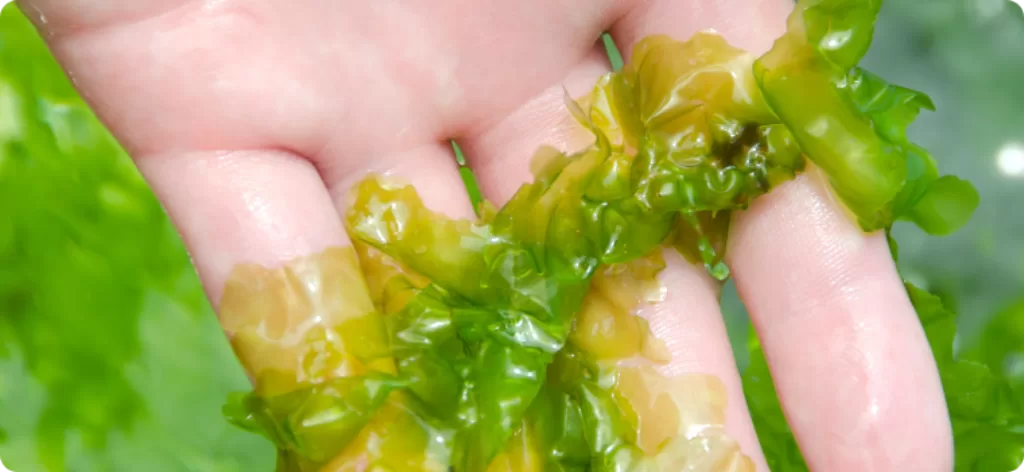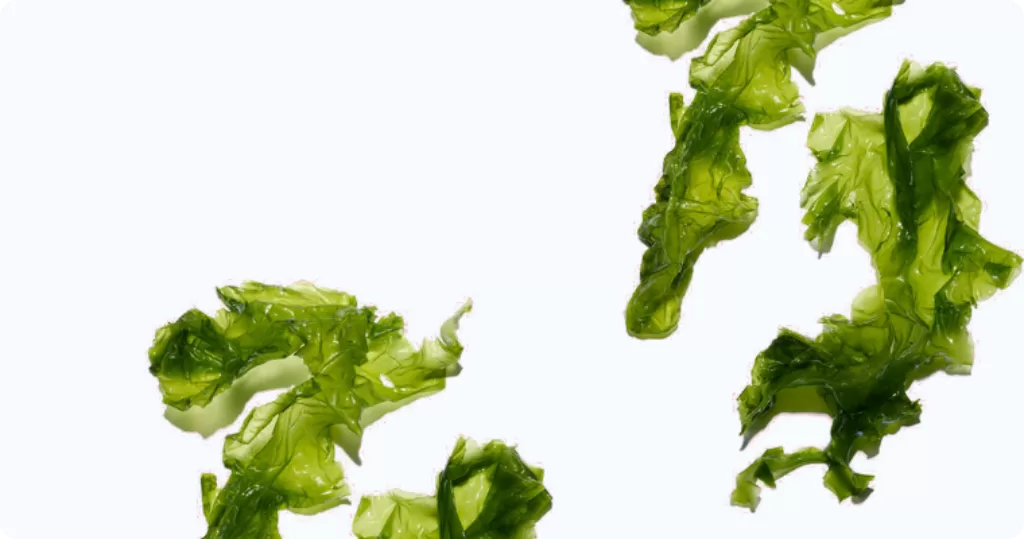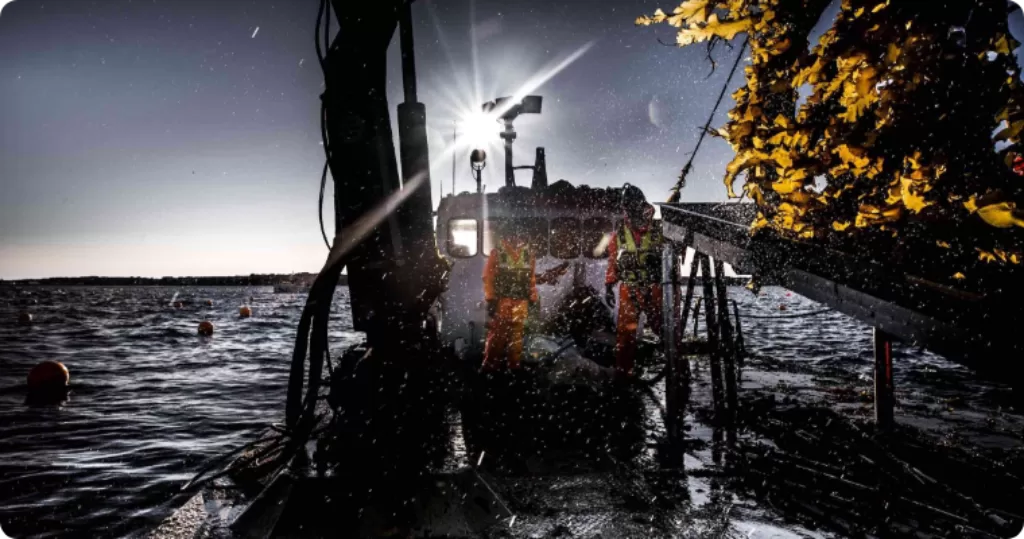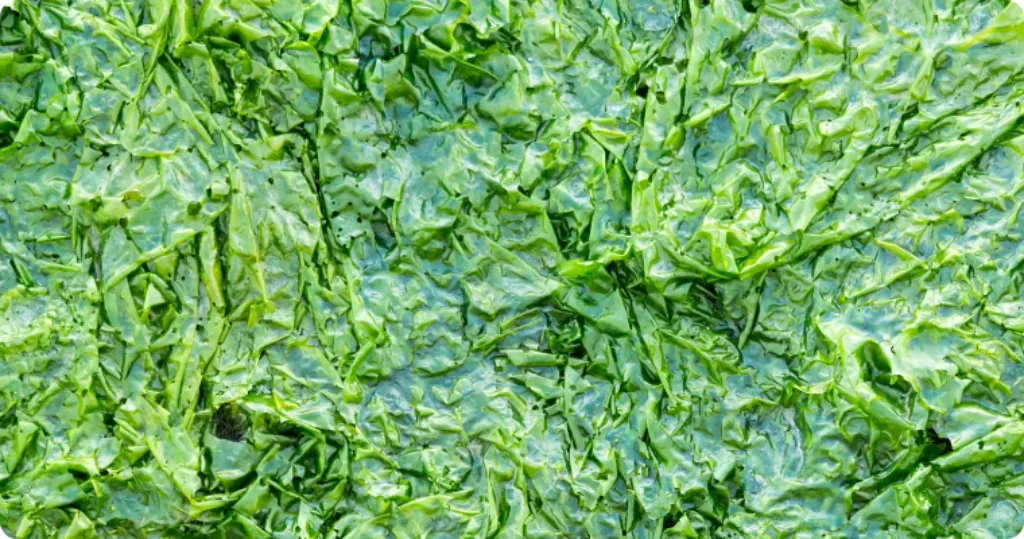Ulva lactuca (Sea Lettuce)

Characteristics
Ulva lactuca is a type of flat green algae of the family Ulvaceae that can be found worldwide. It is considered one of the most usable seaweeds, with applications that include its use in food, agriculture, pharmacology and medicine.
U. lactuca's common name is sea lettuce (because of its appearance). In Asia, it is also called Aosa
or Aonori. It is bright green in colour, with lobed, ruffle-edged leaves that resemble a leaf of lettuce leaves, but that can grow to 50 centimetres in length. The leaves of most forms of U. lactuca are only one or two cells thick, so they often display tattered edges and perforated holes. When dried by the sun, the colour of the seaweed can range from white to black.

Geographical spread & harvest season in Europe
Ulva lactuca grows naturally all over the world – in Europe, North and South America, Africa, the Indian Ocean and Pacific islands, southwest Asia, Australia, and New Zealand. It grows in both littoral and sublittoral waters in depths of up to 75 meters, although it needs a lot of sunlight to flourish. It is perennial, and grows all year, although the largest blooms occur during the summer. Harvest times may vary with location, but the large summer growth lends itself best in many locations to late summer to fall harvest times.

Nutritional content
Ulva lactuca is considered to be a good source of nutrition. It contains high amounts of cobalamin or Vitamin B12, which plays a strong role in maintaining homeostasis in the brain and nervous system, and in the formation of blood. Like other edible green seaweeds, U. lactuca's protein concentration can represent up to 33% of the plant's dry mass. Nutritionally, it has 87 mg of iron and 700 mg of calcium per 100 gram serving. It is also high in sodium, potassium, magnesium, iodine, aluminium, manganese, and nickel and contains Vitamin A, Vitamin B1, Vitamin C, calcium, soluble nitrogen, phosphorous, and numerous trace elements.

In some clinical studies, U. lactuca has been established as a better source of dietary fiber than fruits and vegetables. It has also been shown to have antioxidant characteristics that help to decrease levels of serum total cholesterol, LDL cholesterol, and triglycerides, all of which are significant risk factors for coronary disease. Polysaccharides in U. lactuca have also been demonstrated to have significant analgesic and anti-inflammatory characteristics.
Uses in food
As suggested by its common name sea lettuce, Ulva lactuca is commonly used as a sea vegetable in salads. It is also served cooked, in soups, and along with meats and fish.
- It is a common food source for humans in Great Britain, Ireland, Scandinavia, China, and Japan. In Japan, U. lactuca is often used as a substitute for nori in the preparation of sushi.
- Ulva lactuca is also used as an ingredient in manufactured food products, such as ice cream.
- Carbohydrate is often considered one of the most important nutritional components for metabolism, because it supplies the energy needed for respiration and other metabolic processes. The carbohydrate content of U. lactuca can be as high as 58.1% of its weight.
Uses other than food
Ulva lactuca is increasingly being studied for its potential uses as animal feed and bioenergy, but much of its eventual value may be in the field of medicine.
- U. lactucahas been shown to have strong antibacterial, antifungal, anti-inflammatory, antiviral, antiprotozoal, and cytotoxic properties.
- It has become a prime candidate being studied for its possible use in medicines to treat atherosclerosis, neurological disorders, hypertension, acute respiratory distress, asthma, pulmonary fibrosis, and cancer.
Rolin, C., Inkster, R., Laing, J. "Seaweed Cultivation Manual" NAFC Marine Center. https://www.nafc.uhi.ac.uk/t4-media/one-web/nafc/research/document/seaweed-cultivation/Seaweed-Cultivation-Manual.pdf
Groenendijk, F., et al. "North-Sea-Weed-Chain: Sustainable seaweed from the North Sea; an exploration of the value chain" IMARES Report number C055/16. May 2016. https://edepot.wur.nl/386907
Rasyid A. Evaluation of Nutritional Composition of The Dried Seaweed Ulva lactuca from Pameungpeuk Waters, Indonesia. Trop Life Sci Res. 2017 Jul;28(2):119-125. https://pubmed.ncbi.nlm.nih.gov/28890765/
AlgaeBase. "Ulva lactuca Linnaeus 1753" Accessed 15 April 2021. https://www.algaebase.org/search/species/detail/?species_id=39&sk=0&from=results
University of Rhode Island. "Sea Lettuce (Ulva lactuca)" Accessed 19 April 2021. http://www.edc.uri.edu/restoration/html/gallery/plants/sea.htm
Netalgae.eu. "Seaweed Industry in Europe" www.netalgae.eu. Accessed 13 April 2021. https://www.seaweed.ie/irish_seaweed_contacts/doc/Filieres_12p_UK.pdf
Biological Traits Information Catalogue, "BIOTIC Species Information for Ulva lactuca" Accessed 13 April 2021. https://www.marlin.ac.uk/species/detail/1467
Guiry, MD, Guiry, GM. "Ulva lactuca (Linnaeus), 1753". AlgaeBase. National University of Ireland, Galway. World Register of Marine Species. http://www.marinespecies.org/aphia.php?p=taxdetails&id=145984
Rasyid A. Evaluation of Nutritional Composition of The Dried Seaweed Ulva lactuca from Pameungpeuk Waters, Indonesia. Trop Life Sci Res. 2017 Jul;28(2):119-125. https://pubmed.ncbi.nlm.nih.gov/28890765/
Abudabos, A. et al. "Nutritional value of green seaweed (Ulva lactuca) for broilers." Italian Journal of Animal Science. https://www.researchgate.net/publication/234078711_Nutritional_value_of_green_seaweed_Ulva_lactuca_for_broilers